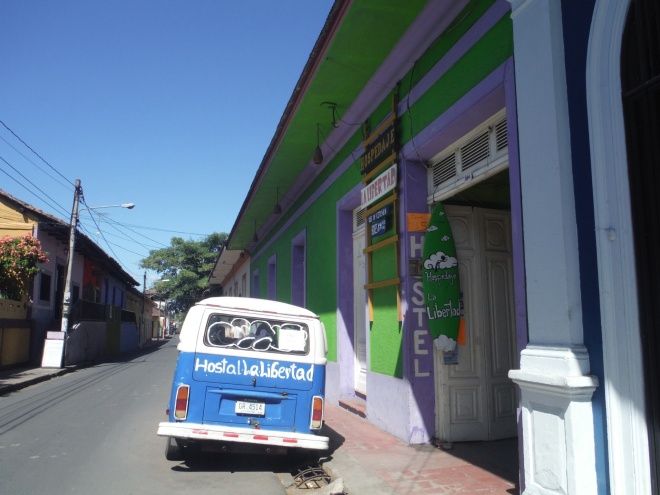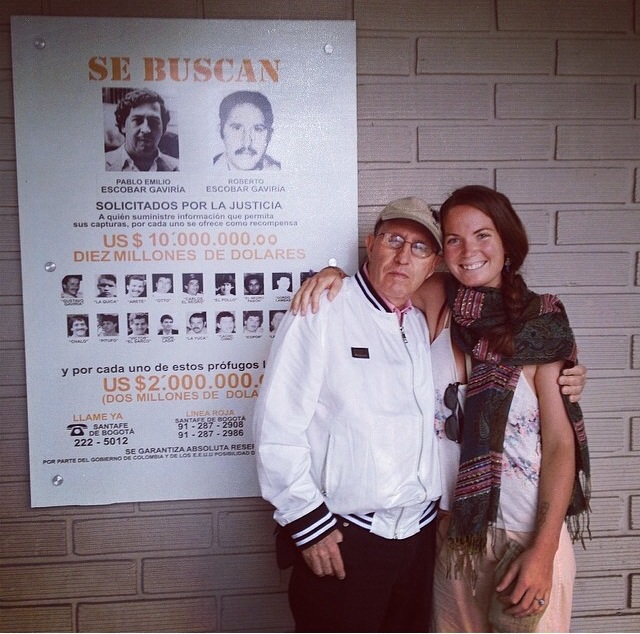
*Danielle and I attempting to figure out directions outside our hostel*
All the travelers I met in Central America claim that Nicaragua is what Costa Rica used to be, before it was flooded with tourism and climbing prices. After spending three weeks in this beautiful country, I can see the allure. The beaches were less crowded, the locals friendlier, and the best part…half the price!! One city I spent a lot of time in was Granada. It’s located on the northwest shore of Lago Nicaragua, a freshwater lake with diverse ecology including sharks!!
My friends Danielle and Brianna joined me on this part of my central and South American backpacking trip. We crossed the border from Costa Rica on a shanty bus in the middle of the night. Backpacks strapped on, we walked ourselves along the dirt path joining the 2 Spanish speaking countries. We had been told that once we crossed into Nicaragua it would be easy to catch another bus the rest of the way to Granada. Of course, there were no such busses waiting for us….A cab driver offered his services, but we were a little reluctant to get into a shabby Nicaraguan taxi waiting at the border in the middle of the night..with no other options and the okay from a local policeman we took our chances with the driver. Lucky for us, he was super friendly and even stopped at the gas station for us to stock up on road beers and plantain chips to get us through the journey.

*The amazing Hostal Libertad!!*
The cab driver dropped us off at Hostal La Libertad. For $5 a night we each had a bed in a dorm room. We were so excited to finally make it, but little did we know what Granada had in store for us…

*the open air common area at La Libertad*
The first problem we faced was a stomach parasite. Not fun. The only good news was that it wasn’t bothered by alcohol, only food. But after a couple days of drinking with the other travelers at the hostel, this liquid diet needed to end. We met an expat couple running an incredible bakery downtown, who told us which meds to get to knock it out. Five pharmacias and a few rounds of charades later we finally solved the problem.
To celebrate my newfound health we decided to go shopping in the main square, where I picked up some cool hand painted art and we devoured bags of liquid cacao..basically the most decadent chocolate drink I’ve ever tasted.
*Drinking liquid cacao in the main square*
Thinking our bad luck was over, we went on a little adventure to find some indulgences. Our English friends had drawn us a little map and told us to look for an old lady by a river…by the slums. Now I should preface this with the fact that I don’t always think through all my “plans” and “adventures”.
An hour later we hadn’t found the old lady with the goods. Danielle told us she had a bad feeling and that we should go back. Brianna and I told her we would after going down one more street. At this point we were walking around a neighborhood composed of dirt alleyways and shacks made of junkyard materials. It was mid afternoon so we felt safe, thinking nothing would happen in broad daylight. As we are walking a teenager swerves close to us on his bike making us jump, the next second I hear Danielle screaming and running after a local teen!
He had grabbed her wristlet when we jumped and bolted down another alley. Instinctually I started running after Danielle, breaking my crossover purse and throwing it to Brianna, standing shell shocked behind me. She starts screaming in Spanish that we’ve been robbed..”ayudame, ayudame!” Local residents pop out of their shacks to see what’s going on. At this point kids start chasing with Danielle and I, trying to catch the culprit. Eventually at least 25 kids and teens from the slum were helping us. Moms brought us water and helped Brianna to call the police.
We hear the sirens and turn to see a pickup truck with fifteen policemen and two police motorcycles. Shock is an understatement. It was as if a bank had been robbed! The policemen quickly came over to the 3 petrified white girls, standing in a Nicaraguan slum, surrounded by a community of over 50 helpful locals. We explained to them what had happened, leaving out why we were really in the slum, claiming we had gotten “lost”. While this is going on, we see them unloading a wheel barrow from the pickup, taking it into one of the shacks. Other policeman dragged the culprit in as well. We could hear screaming and shouting from inside the shack and were beyond afraid of what was going on, and what was going to happen.
Inside the wristlet, Danielle had her iPhone, passport, credit cards, and over $250 cash. Losing it would be devastating, especially considering the fact that we had a flight booked to Colombia the next week, where arriving sans passport is not an option. While the policemen were inside, the mother of the culprit came over to us with fifty dollar US bills in her hand, offering us the money to not file a police report. In broken Spanish we explained that we needed the passport and credit cards back, we didn’t care about the money but had to leave the country soon and couldn’t do so without those essentials. She started crying and we felt hopeless.
The policemen eventually come out of the shack with the culprit in the wheel barrow(?!?!) and chuck him into the bed of the pickup. They ask us to get into the front of the truck with them. Sandwiched in the middle of two policemen, we drove to the station. It’s a long and grueling process at the station, where no one spoke a word of English. They brought us into a room for questioning with the culprit sitting on the floor less than three feet away. We were terrified to be in the same room as him. He had a deranged look in his eyes and seemed to be laughing.
Several hours later, with no sign of the wristlet, we were told to come back the next morning to see if they were able to retrieve any of the stolen items. Feeling defeated, we walked out of the station to call a cab. The thought of having to call our parents and explain what had happened, having to change our flight, and trying to get a passport replacement were daunting.
For the second time, we were blessed with another stroke of luck. The cab we waved down pulled over to us. A young girl steps out and in her hand was the stolen wristlet… We ran over and enveloped her in a giant hug of gratitude. The policemen had us come back inside to examine it. Inside, was the passport and all of Danielle’s credit cards. Not inside, was all of the cash, coins, and iPhone. We all breathed a sigh of relief at not having to change our travel plans nor having to admit to our parents that Nicaragua was possibly not as safe as we claimed. We were grateful to the help of the local community and the fact that all of us were left unharmed.
This may not have been the best first impression of Nicaragua, but it left us with some pretty wild stories to tell, and a fair warning to be more cautious for the rest of the journey.
















